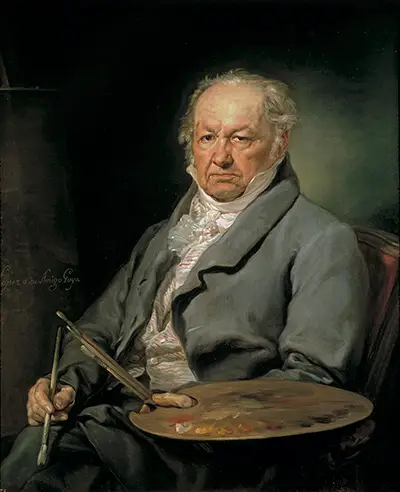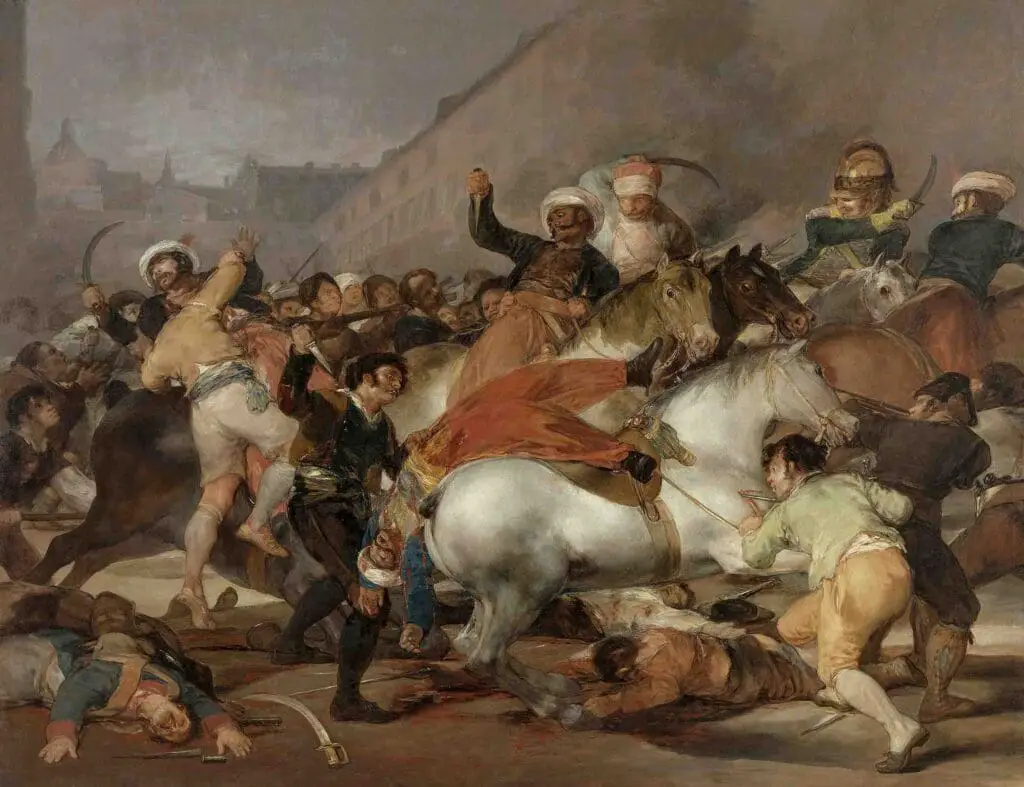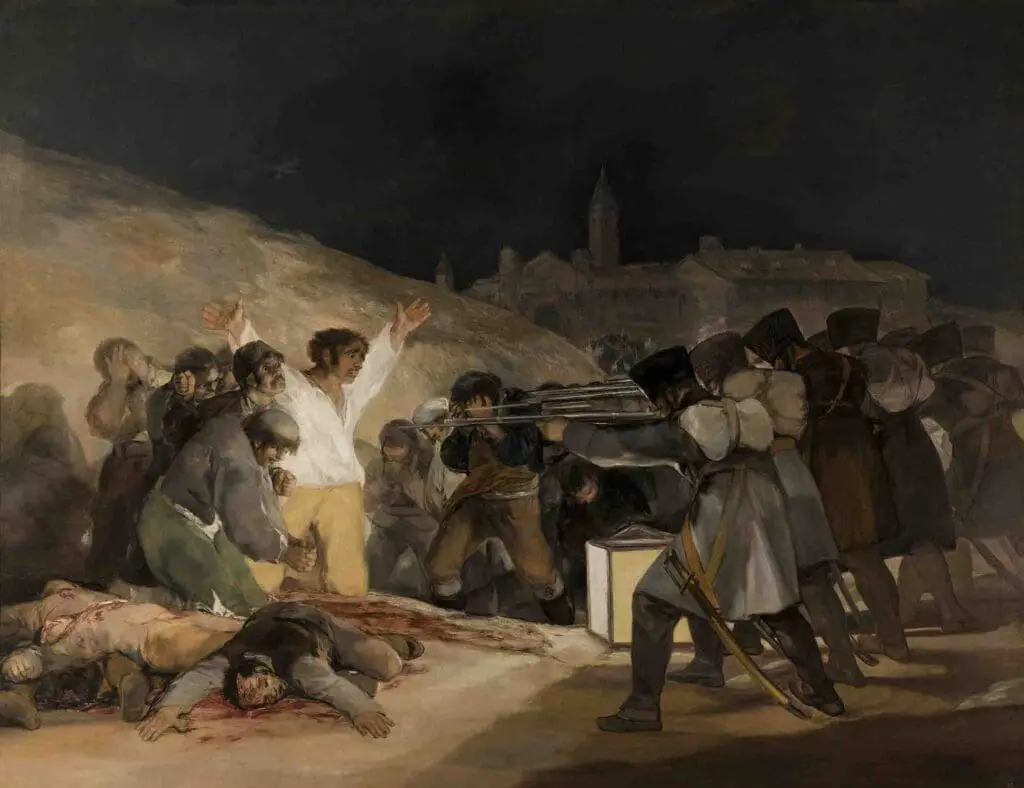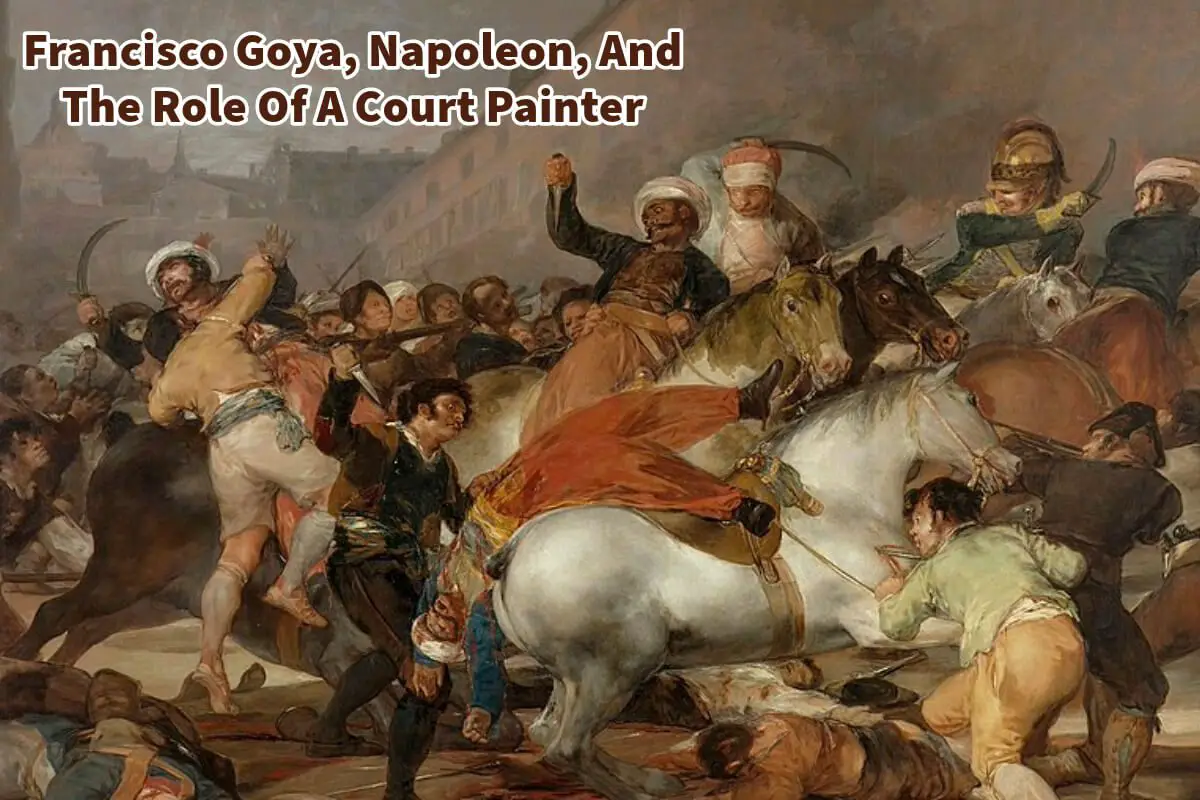When examining Francisco Goya’s paintings, contextualizing them within his era’s political milieu is essential. These tumultuous events significantly influenced and molded him as the artist we recognize today.
Francis Goya lived in a time when Europe was changing. It was a time of upheaval and turmoil. “The Disasters of War” is a poignant testament to this influence on his work. Goya is a testament to an artist who, amidst immense political upheaval, had to navigate his dual roles as a citizen and a court painter of his epoch. We explore this time and its effect on Francis Goya’s works of art.
Table of Contents
Francisco Goya, Napoleon, And The Tumultuous Role Of A Court Painter
The realm of art is often viewed as a serene sanctuary, detached from the mundane and chaotic sphere of politics. However, history has shown us that the two worlds often intersect, sometimes with jarring results. At the epicenter of this collision in the early 19th century stood Francisco de Goya, Spain’s most prominent painter, caught amidst the political dilemma of Napoleon Bonaparte’s ambitions.

A Changing World Of Europe In 1808
By 1808, Goya had already firmly established himself in the Spanish court, enjoying the patronage of Kings Charles IV and, later, his son Ferdinand. Yet, the landscape of power was quickly shifting.
Napoleon’s mighty armies swept through Europe, and Spain was not exempt from this upheaval. With Charles IV and Ferdinand ousted, Napoleon’s brother, Joseph Bonaparte, was installed as the monarch.
What did this mean for Goya? While his allegiance to Spain was undeniable, Goya was a pragmatist. To survive these tumultuous times, he continued as a court painter. This position required him to portray Spanish generals and their French counterparts, including the illustrious Duke of Wellington.
The Disasters Of War And Francis Goya’s Art
Though Goya may have painted the portraits of French officials, his sentiments towards the occupation and war were profoundly expressed through his etching series, The Disasters of War.
These were not mere representations of war but a visceral outcry against its brutality and horror. The gruesome imagery, far from being objective, highlighted the devastating impact of war on the ordinary person.
His choice of dramatic compositions made them even more evocative, as they blurred the lines between documentary and artistic representation and served as an early precursor to war reportage in art.
A Return To Spanish Rule In 1814
As the winds of change blew again, 1814 marked the restoration of Ferdinand VII to Spanish Rule. The tides had turned against the French, expelling them from Spain.
Despite his association with the French regime, Goya managed to find favor again in the Spanish court. During this time, he painted two of his most iconic works: “The Fight of the Mamelukes” and “The Executions.”


Both monumental pieces commemorated the uprising in Madrid, and their sheer realism and evocative power have left an indelible mark on art history.
Yet, Ferdinand VII’s reign wasn’t one of enlightenment or prosperity. Under his rule, Spain veered towards oppressive autocracy. In his portraits of Ferdinand, Goya did not flatter; he revealed. The visage of a tyrant emerged, reflecting the grim reality of his regime.
Personal Tribulations And Later Works
The later phase of Goya’s life was marked by deep introspection, perhaps stemming from his experiences and the world he inhabited. While he painted fewer official portraits, his works became increasingly reflective and subjective, delving into the depths of the human psyche and spirituality.
However, Goya’s most enigmatic and perplexing works came toward the end of his life. The “black paintings” that adorned his country house, Quinta del Sordo, and his etching series, Los proverbios or Los disparates, were surreal, bordering on nightmarish.
These weren’t mere paintings but glimpses into a troubled mind, resonating with themes of despair, cynicism, and pessimism.
Francisco Goya’s journey, intertwined with the political upheavals of his time, serves as a stark reminder of the profound influence of societal events on individual lives, even on someone as illustrious as a court painter.
Francisco Goya’s Twilight Years And Final Years In Exile
As the sun began to set on Goya’s life, political unrest and the re-establishment of an authoritarian regime in Spain prompted him to seek solace and peace away from his homeland. In 1824, Goya found himself navigating the streets of Bordeaux, having sought permission for a health-driven vacation to France.
This move marked his final years, during which, though physically in France, his heart and memories oscillated between his French surroundings and the Spanish terrains he had left behind.
Paris served as a brief muse, but in Bordeaux, Goya found a new home. While age and physical limitations began to show, Goya’s spirit remained undeterred.
Old age did not dampen his creative flair. On the contrary, it offered him a new lens through which he continued interpreting and depicting the world. From the delicate brush strokes in paintings to his experiments with the innovative medium of lithography, Goya continued to break boundaries.
Some of his last creations include exquisite genre subjects and intimate portraits of friends who, too, had sought refuge in exile. These portraits, including those of Don Juan Bautista de Muguiro, Leandro Fernández de Moratín, and Don José Pío de Molina, encapsulated the culmination of Goya’s lifelong evolution in artistry.
They exhibited a profound simplicity, with Goya employing a symphony of light and shade, minimizing details, and subtly employing color, seamlessly merging form and character.
Francis Goya’s Legacy: The Revolutionary Maestro
While legends might weave tales of Goya’s rebellious nature, there is no denying the revolutionary essence of his art. Living through seismic socio-political shifts, Goya’s vast oeuvre is a testament to his surroundings. His work serves as a visual narrative, a chronicle that delves deep into every nuance of life in his epoch.
While Goya might not have had immediate followers who emulated his style, the ripples of his genius resonated far and wide. His innovative and audacious approach to art left an indelible impression on subsequent generations of artists, who would steer the course of art through various movements.
The likes of Eugène Delacroix, who stood at the forefront of the Romantic movement, held Goya in deep reverence.
But Goya’s influence was not limited to one epoch or movement. From Romanticism and Realism to Impressionism, and even further into 20th-century Expressionism and Surrealism, echoes of Goya’s genius can be discerned. Even in the 21st century, art connoisseurs, scholars, and modern artists turn to Goya’s masterpieces for inspiration and reflection.
Through his illustrious career and relentless spirit, Francisco Goya crafted a legacy that transcended borders and time. From the bustling streets of Madrid to the serene alleys of Bordeaux and far beyond, Goya’s artistry continues to shine, a beacon of revolutionary creativity that challenges and inspires generations.
His ability to adapt and retain his essence is a testament to his genius. In his paintings, etchings, and murals, Goya didn’t just capture a moment in time; he encapsulated an era—an era of political tumult, societal upheavals, and personal tribulations.
Anita Louise Art is dedicated to art education, great artists, and inspiring others to find and create their art. We love art that uplifts and inspires. #ArtToMakeYouSmile! #ArtToMakeYouHappy!
If you are interested to see any of my art, you can find out more by clicking here. If you are interested in what inspires me and my paintings, you can discover more by clicking here.
We have a free newsletter and would love you to be part of our community; you can subscribe to the newsletter by clicking here. If you have any questions, I would be happy to talk to you any time. You can reach me, Anita, by clicking here.
Subscribe to our Anita Louise Art YouTube Channel filled with great videos and information by clicking here.
Related Questions
Why Do People Say, ”Life Is Like Drawing Without An Eraser?
Often, artists, myself included, will use an eraser to remove any marks or measurements we may have made on a paper to measure out and organize their drawings or artwork on their canvas or paper. For most artists having a good eraser is essential.
By clicking here, you can learn more by reading Why Do People Say, ”Life Is Like Drawing Without An Eraser?.
Is Communism Good For The Arts?
Communism is not suitable for art, and for many artists under Communism, art should have a purpose and way to help further the communist ideals and ideology. In a Communist society, many artists are labeled as dissidents; others are forced to use their talents to create propaganda art.
By clicking here, you can learn more by reading Is Communism Good For The Arts?.
12 Years Leonardo Painted Mona Lisa’s Lips, Facts Or Fiction?
There is no evidence to show that Leonardo da Vinci spent 12 years painting the Mona Lisa smile. Most scholars believe that he painted the painting in 4 years but then had the painting much longer in his possession. He could have worked on it a bit or adjusted it when he had it in his possession, but there is no evidence to show that.
By clicking here, you can learn more by reading 12 Years Leonardo Painted Mona Lisa’s Lips, Facts Or Fiction?.


